Tether has achieved remarkable profitability, amassing $160 billion in USDT issuance with quarterly profits reaching approximately $4.9 billion.
To drive further growth, Tether is expanding beyond mere issuance to focus on the "utilization" of USDT in the onchain ecosystem.
To accomplish this, Tether is pursuing a multi-chain expansion strategy using USDT0 while supporting on building its own USDT focused ecosystem based on separate blockchains like Stable and Plasma.
Stable L1 offers a distinct advantage with its "Enterprise-Focused" strategy. It has features like guaranteed blockspace, a transfer aggregator, and confidential features for compliance. By leveraging its investor networks with its infra, Stable has the potential to fuel Tether's next growth phase.
Tether, the world's largest stablecoin issuer, has established a unique position in the global market as a "Denationalized USD Stablecoin Issuer." Tether's USDT is pegged 1:1 to the US dollar but operates relatively freely from US government regulations and pressures. Tether CEO Paolo Ardoino stated that as the US government intensifies stablecoin regulations, Tether is considering "launching a separate stablecoin specifically for the US market." This strategic choice implies maintaining the current USDT operations globally while creating a new regulatory-compliant stablecoin exclusively for the US market.
This strategic decision clearly indicates that Tether particularly targets developing countries outside the US. CEO Paolo explicitly mentioned, "USDT's primary users are concentrated in emerging markets," citing specific countries such as Turkey, Vietnam, Brazil, Argentina, and several African nations. In these regions, where local currencies are unstable or the dollar supply is insufficient, USDT effectively serves as an alternative to the dollar. Paolo emphasized that Tether would "serve as the last-mile dollar for the financially underserved." With growing global demand, USDT has established itself as a trading currency on international exchanges like Binance and Bybit and is even priced in USDT at retail stores in countries like Bolivia.
Ultimately, Tether has secured stable market positioning globally by providing a dollar alternative in a denationalized way.
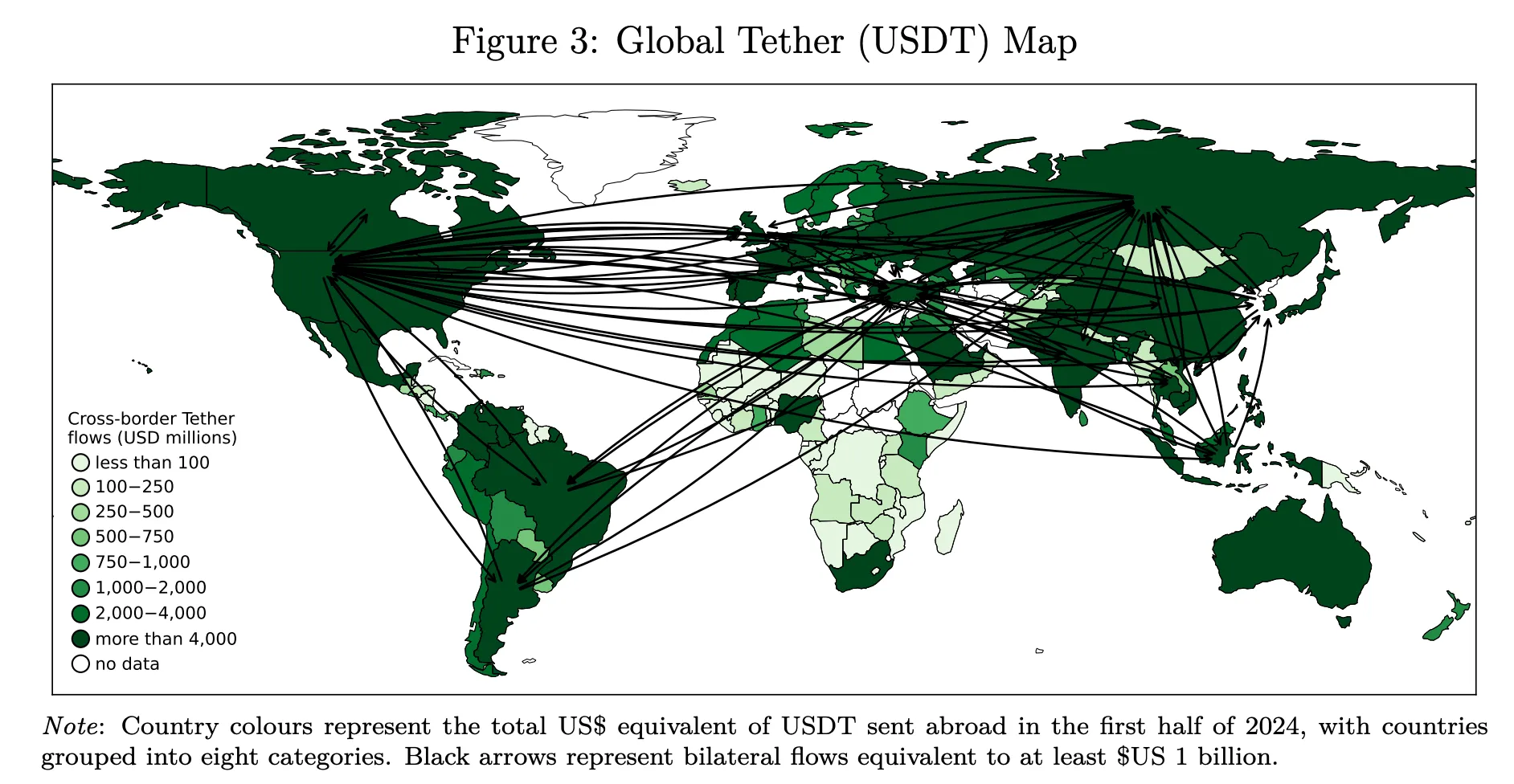
Source: DeFiying gravity? An empirical analysis of cross-border Bitcoin, Ether and stablecoin flows
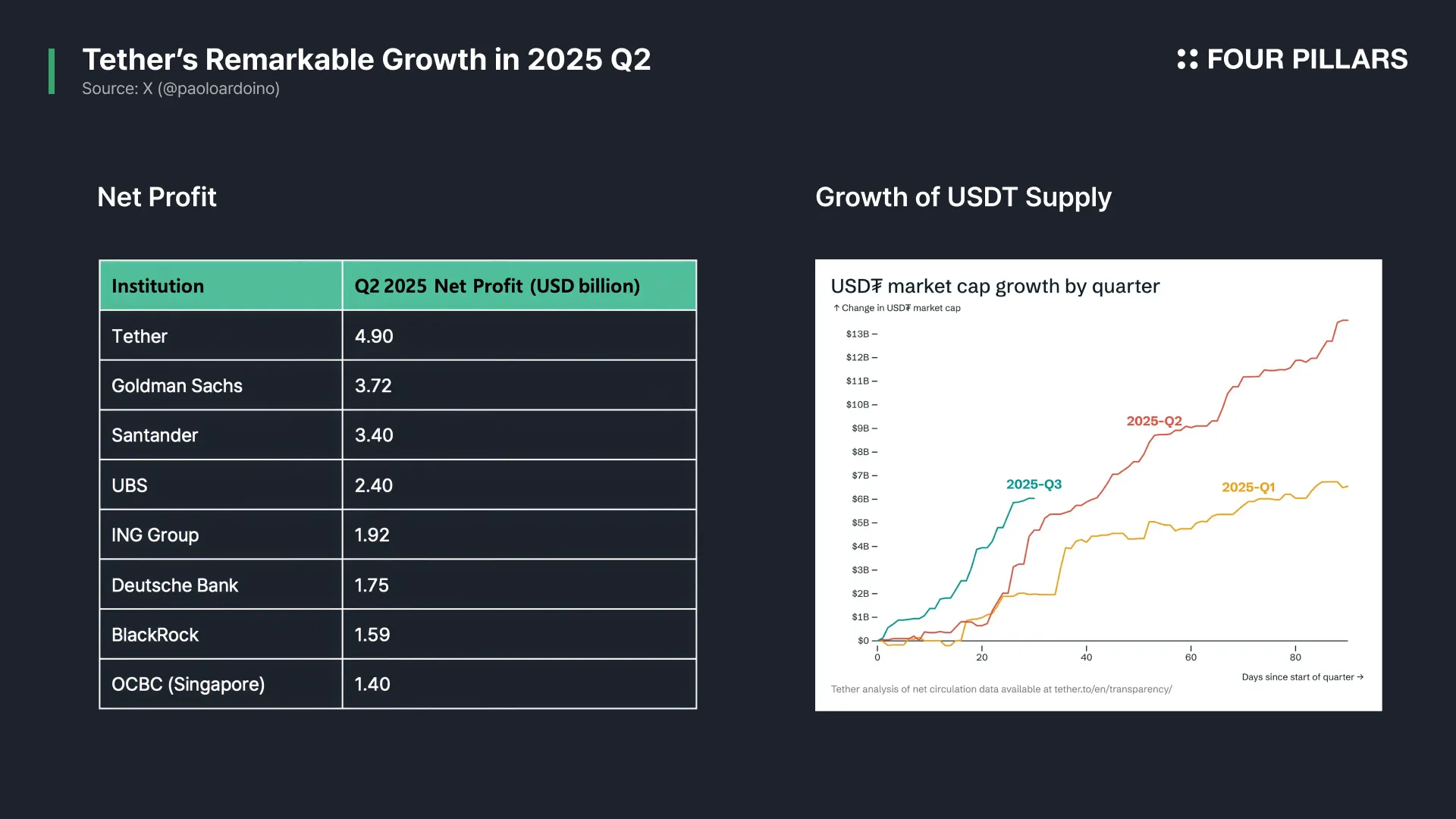
The surge in global demand for USDT directly translated into Tether's profitability. According to Tether's Q2 2025 financial report, $13 billion worth of new USDT was issued in just one quarter, with quarterly net profit reaching approximately $4.9 billion. This massive profit primarily results from investments in US Treasuries and diverse assets such as Bitcoin and gold. Currently, Treasury bills comprise approximately 70% of USDT's collateral assets.
Due to this structure, Tether invests stablecoin issuance funds into secure assets like US Treasuries. Tether now holds more US treasury bills than South Korea, ranking as the 18th largest holder globally, positioning itself as one of the world's most profitable financial companies.
Its market share is also dominant. As of 2025, the total issuance of USDT reached a record-high of approximately $160 billion, far ahead Circle's USDC, which stands at around $60 billion. USDT has become a widely-used stablecoin in both centralized exchanges (CEX) and decentralized exchanges (DEX), holding an overwhelming market share exceeding 60%.

Source: X (@immutablejacob)

Beyond USDT, Tether is expanding growth possibilities through initiatives related to issuance, such as tokenized gold (Tether Gold) and the asset issuance platform Hadron. However, future growth will require strategic expansion beyond “issuance” to the "utilization" aspect as well. To achieve this, Tether is simultaneously pursuing a multi-chain expansion strategy using USDT0 and building its own ecosystem based on separate blockchains like Stable and Plasma.
First, Tether's expansion strategy into multiple chains under the name USDT0, leveraging LayerZero's Omnichain Fungible Token (OFT) standard, needs to compete with USDC. Currently, USDC leads in several chains like Solana and Hyperliquid, and recording significantly higher utilization in DeFi compared to USDT. For instance, USDC achieved $3.7 trillion in CEX transactions and $9.0 trillion in DEX transactions, whereas USDT had $7.2 trillion on CEX but only $1.6 trillion on DEX. This implies USDT is primarily used for international remittance and large CEX transactions, while USDC is more favored for collateral or swaps in DeFi protocols. Thus, we need to monitor how Tether's USDT0 expansion strategy reshapes onchain market dynamics.
Additionally, Tether’s second strategy - ecosystem building through Stable and Plasma - can be the important growth catalyst. Their primary competition will be existing chains like Base, Arbitrum, and Solana, but most directly, Tron, currently the main USDT transmission chain. Tron currently derives 99% of fee revenue and 98% of transaction volume from USDT transfers, relying on CEXs purchasing and staking TRX for cost reduction. However, Tether gets 0 fees from here which opens an opportunity here. Also, given Tron’s ongoing risks associated with controversial figure Justin Sun, exchanges and institutions might migrate if sufficiently incentivized.
This is where Stable can leverage its strength. Given Stable's solid enterprise-centric infrastructure and partnerships, it has considerable potential to broaden USDT's use cases significantly. Can Stable become Tether's next growth catalyst? Two strategic stages can enable this.
2.1.1 Stable’s Enterprise-Centric Infrastructure
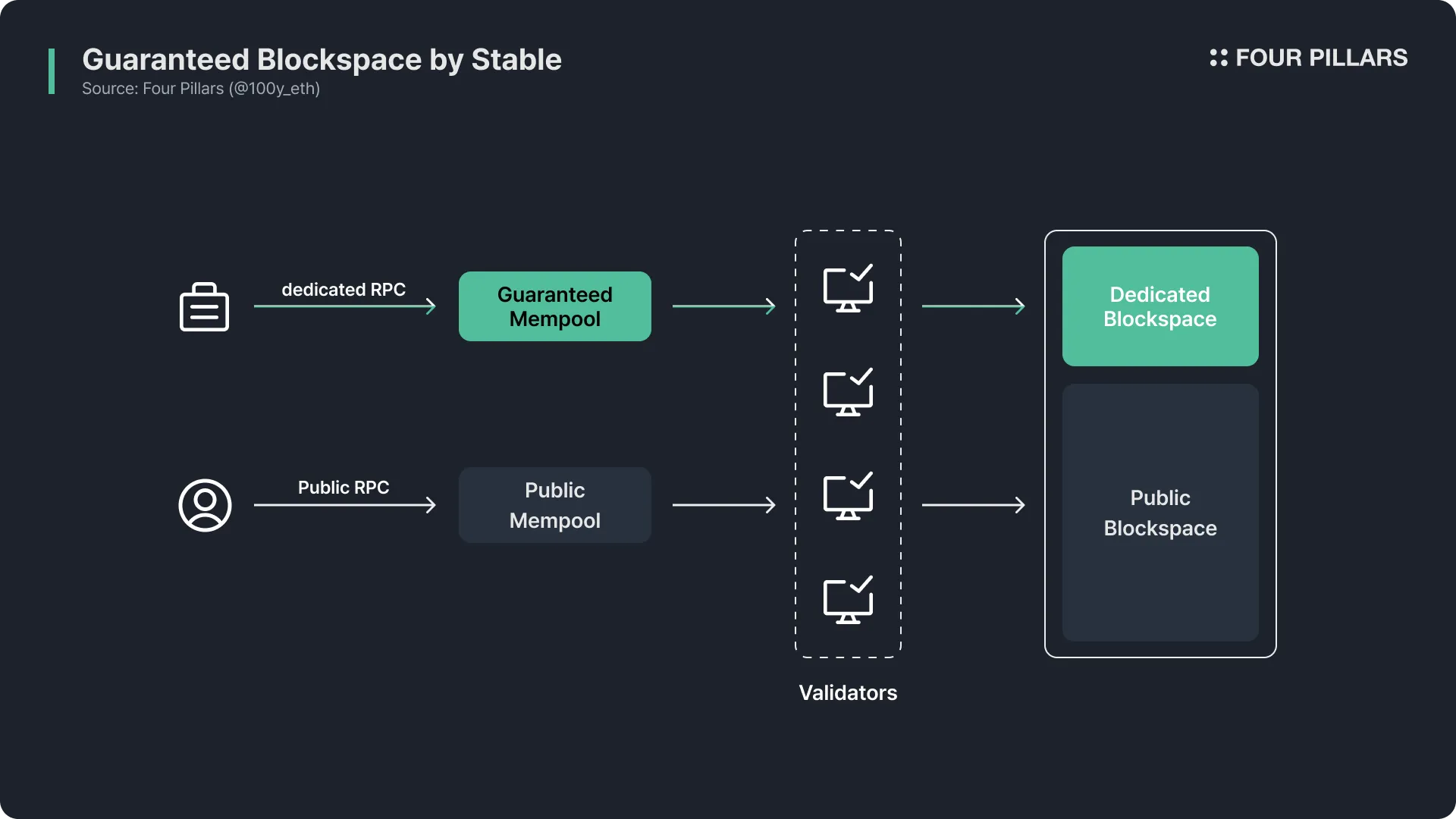
Stable's infrastructure is built from the ground up to meet institutional demands and requirements. A key example is solving the gas fee problem by allowing USDT to be used directly as a gas fee. This lets users process blockchain transfers without needing to buy or manage separate gas tokens.
Stable also addresses network congestion caused by frequent large-scale institutional transactions through two key features. First, it offers "Guaranteed Blockspace" that institutions can prioritize to prevent delays in critical transactions. Second, it introduces a "USDT Transfer Aggregator" that significantly increases transmission speed and throughput by bundling multiple transactions into one.
Additionally, Stable is developing a confidential transaction feature to protect sensitive corporate data. With these capabilities, Stable's infrastructure aims to create an institutional-friendly blockchain that makes usage straightforward for enterprises.
2.1.2 Stable’s Connection with Enterprises
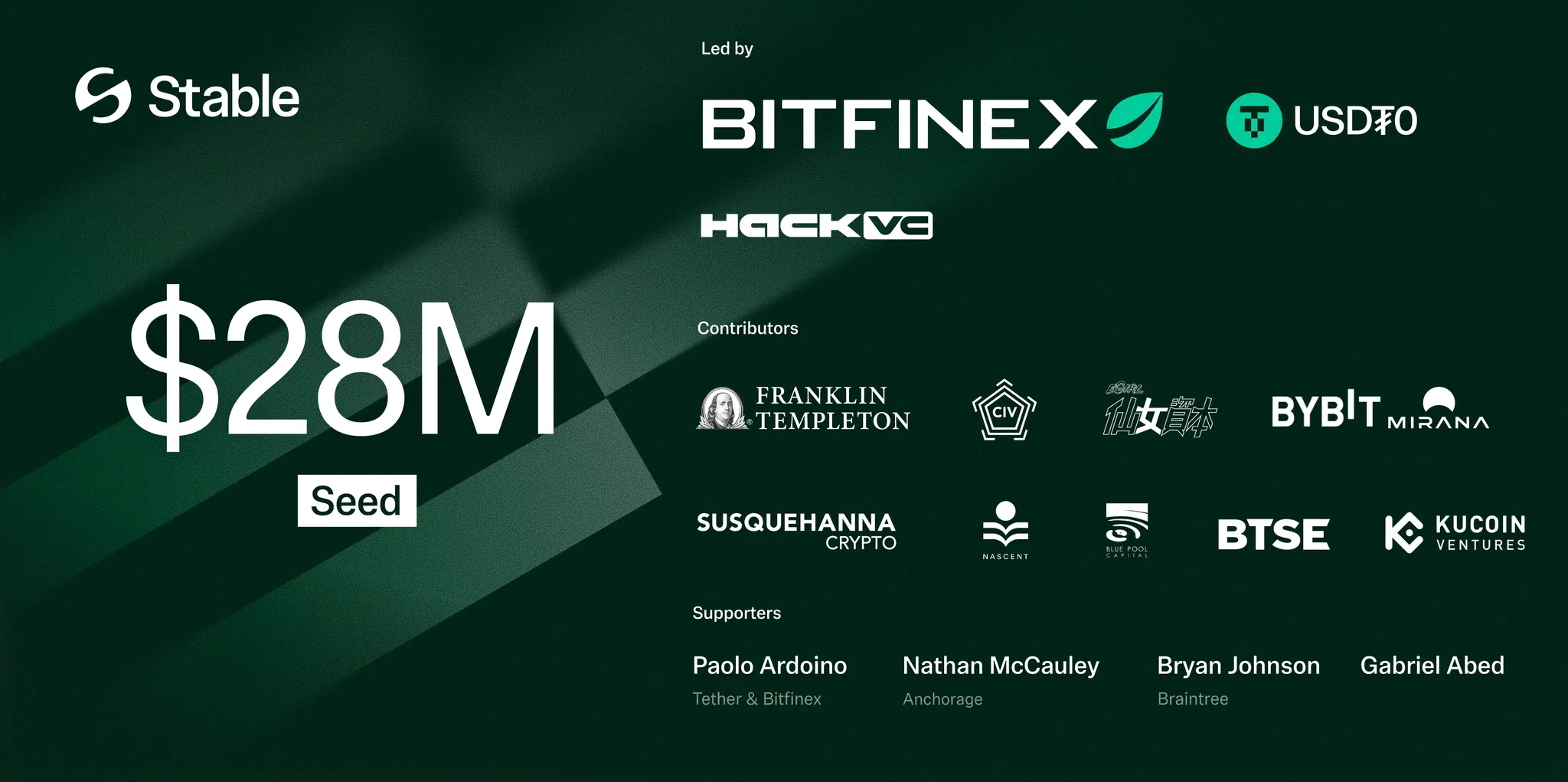
Source: X (@Stable)
To support such infrastructure development, Stable recently secured $28 million in seed funding. The investment lineup was led by Bitfinex, USDT0 and HackVC (Bitfinex has Tether CEO Paolo as its CTO, and USDT0 is the multichain version of USDT). It also includes renowned trading firm Susquehanna International Group, global asset manager Franklin Templeton (with $1.53 trillion AUM), and major exchanges such as Bybit and BTSE. Additionally, Stable boasts a broad investor network from both traditional finance and the crypto industry, including angel investors and advisors like Tether CEO Paolo Ardoino, Binance Chairman Gabriel Abed, and Anchorage CEO Nathan McCauley.
Stable’s next critical task is effectively onboarding numerous real-world businesses and institutions. Stable’s investor network already includes global asset managers and major exchanges, placing it in a favorable position for securing an initial user base.
For instance, major exchanges like Bitfinex, closely associated with Tether, and Bybit, an investor in Stable, are highly likely to support the initiative actively. Centralized exchanges (CEXs), currently processing large USDT volumes via the Tron chain, have strong incentives to transition to Stable's more efficient environment. Just as Tron succeeded by onboarding major exchanges, Stable can similarly maximize network effects by partnering with leading exchanges and incentivizing users.
Tether has also recently solidified its foundation through investments in real assets and industrial infrastructure. Early in 2025, Tether acquired a 70% stake in Adecoagro, a major Latin American agricultural and energy conglomerate, enabling the use of USDT for settling transactions involving grains, crude oil, and ethanol in the region. Additionally, Tether strategically invested in the African fintech company Shiga Digital to expand USDT use in FX trading and corporate finance. It also acquired a 31.9% stake in the Canadian-listed mining company Elemental, enhancing its influence in commodity markets. These entities are also likely to strategically utilize Stable.
Large institutional transactions represent a stable and highly profitable market compared to retail transactions, making it attractive for Stable. Stable is particularly focused on turning institutional-scale large transactions into a reliable and lucrative business, aiming to ensure the flow of USDT dollars occurs not only on external public chains but also within the broader Tether ecosystem. This represents Tether’s powerful strategy for securing "chain sovereignty."
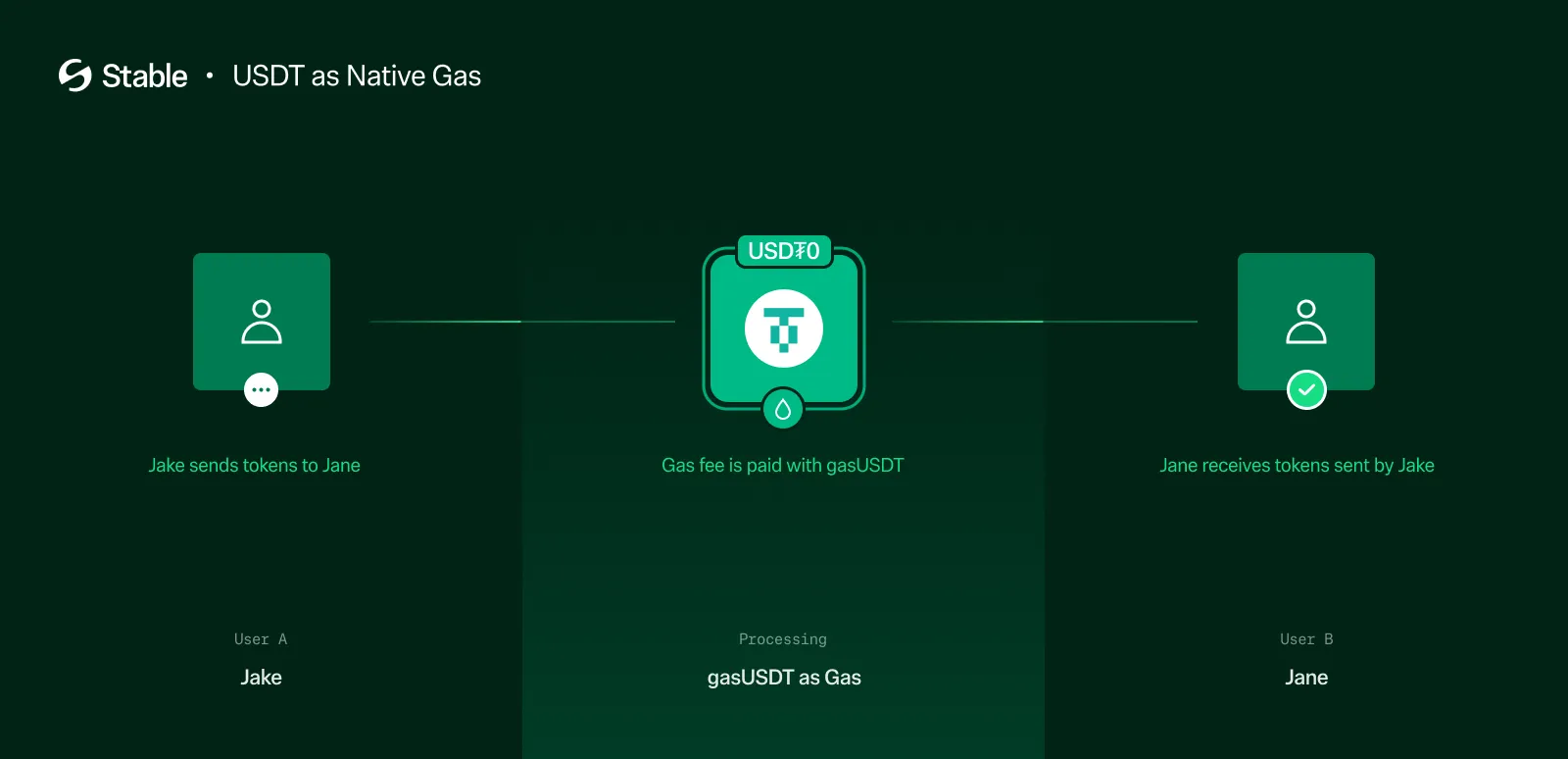
Source: USDT as Gas Token - Stable
While Stable offers enterprise-focused infrastructure, it is not exclusively for businesses. Stable also provides a highly user-friendly environment for general users, exemplified by free USDT transfers and the direct use of USDT for gas fees, eliminating the need for separate gas tokens. It also offers an intuitive proprietary wallet, simplifying access even for users unfamiliar with blockchain. So with the onboarded enterprises, Stable can bring their userbase onchain.
A strategy of collaborating with exchanges to rapidly migrate their existing user bases to Stable’s ecosystem has proven highly effective, with Coinbase’s Base chain serving as a successful example. Coinbase facilitated an easy transition for its existing customers by eliminating transfer fees for USDC transfers to Base and enabling direct use of lending protocols like Morpho within the familiar Coinbase app. Promotional rewards for initial deposits or transactions further accelerated early user adoption, significantly contributing to Base’s rapid growth. As Stable serves as the chain partner for Tether, there are potential here.
Strategic partnerships with banks and fintech companies can also serve as crucial onboarding strategies. For example, PayPal’s PYUSD currently operates on six blockchains, including Ethereum and Solana. If PayPal partners with Stable to allow PYUSD for gas fee usage, it gains a powerful incentive to build more efficient payment infrastructure centered around Stable. This could seamlessly integrate PayPal’s default wallet and payment infrastructure with Stable, significantly expanding Stable’s presence in everyday payment environments.
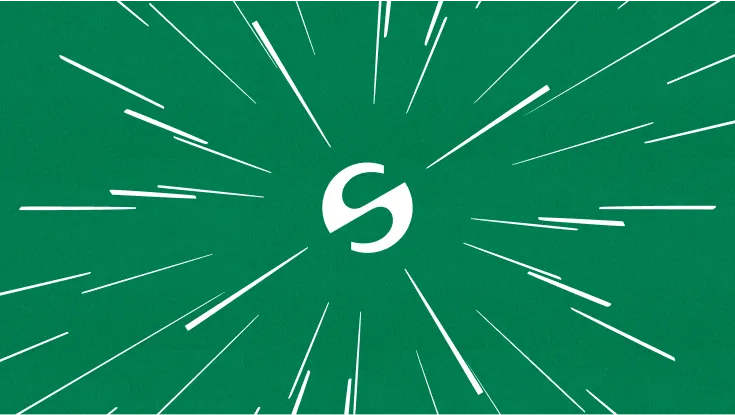
Source: Why Stable - Stable
Based on Tether's past successes and future strategies, Stable could become a crucial driver in Tether's next growth phase. After achieving significant initial growth through USDT issuance, Tether is now pursuing secondary growth by reducing its reliance on Tron and developing its own infrastructure. While creating a distinctly differentiated stablecoin-centric chain presents challenges, Stable's strategy is straight - establishing institutional infrastructure that secures steady demand from enterprises and corporate customers. This approach represents a strategic diversification toward expanding profitability through stablecoin "utilization" focused on businesses and their customers.
However, challenges remain, including the lack of successful precedent for enterprise-focused stablecoin-centric chains and continuous regulatory risks. Strong regulations in advanced economies like the US could narrow Tether’s position. Still, Tether is expected to maintain its decentralized ethos through strategies like issuing separate compliance-focused stablecoins. Moreover, despite competition from stablecoins like Circle’s USDC, Tether’s overwhelming liquidity, brand trust, and burgeoning ecosystem constitute significant barriers for competitors.
If Stable is successfully implemented, Tether could also benefit from the entire stablecoin value chain from issuance to distribution, trading, and settlement. This could become a launchpad for Tether’s next leap, strengthening current USDT leadership and boosting the broader stablecoin industry’s growth.
Under current conditions, Stable seems poised to fuel Tether's next growth phase, in the wave where enterprises are actively entering crypto.